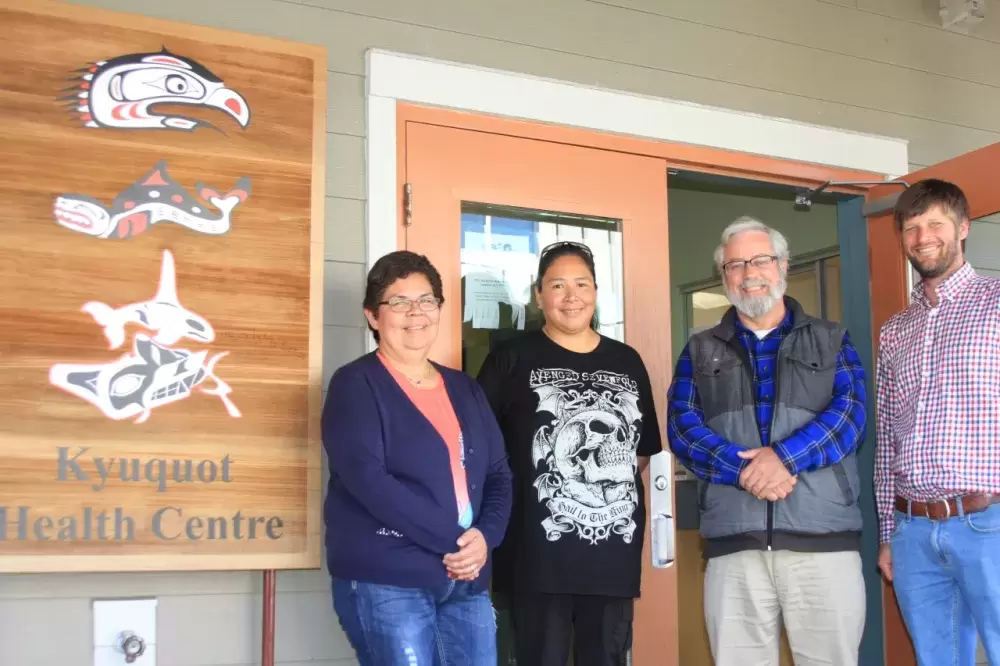Residents of the Ka:'yu:'k't'h'/Che:k'tles7et'h' First Nations’ reserve of Houpsitas are seeing an increased access to health care one year after the opening of a clinic in the Kyuquot community.
Until October 2017 those who lived in Houpsitas, which has over 160 residents according to Nuu-chah-nulth Tribal Council records, had to cross the water for medical attention at the nearby health clinic on Okime Island. This changed a year ago, when the Kyuquot Health Centre offices opened on the second floor of a new three-storey building in Houpsitas.
Enid O’Hara, Island Health’s manager of rural services, said that this has benefitted most people living in Kyuquot, which is located on Vancouver Island’s northwest coast. Now a registered nurse works Monday to Thursday in the new centre, then Fridays at the old health outpost on Okime Island. The nurse resides in Okime and is on call evenings and weekends.
“The vast majority of the population lives on the Houpsitas side, for them if has made health care way more accessible,” O’Hara said. “In Kyuquot if you don’t have access to a boat you previously didn’t have access to health care easily. You had to have a friend or a family member or somebody take you across.”
“People were more reluctant to go to the clinic over there partially because transportation is an issue,” said Steinar Vage, the Ka:'yu:'k't'h'/Che:k'tles7et'h' First Nations’ director of community services. “[Health clinic staff] find that a higher number of patients will see them during work hours and there’s less cases of emergency after hours because people utilise the clinic more.”
“The services have remained the same…the availability has become easier,” he added.
The new health centre offers basic medical services to treat ailments such as commons colds, minor skin wounds and urinary tract infections. Over the last year the facility has seen approximately 200 visits a month as patients appear to be seeking medical attention sooner, said O’Hara.
“We are seeing people for follow-up, which didn’t often happen before,” she said. “It’s certainly a lot busier because the majority of the population is closer to care.”
Vage said a doctor usually flies in every other week for three hours of scheduled appointments.
“We have a list here of people who need to see the doctor and they will be called in,” he said. “The doctor will see them and either prescribe medication, refer them to a specialist or to outside medical treatment.”
Bearing the familiar mark of a Red Cross station, the Okime clinic was established decades ago to serve several canneries that once operated in Kyuquot. O’Hara said the Red Cross outpost originally offered a pay-for-service model of care that possibly dated to before World War II.
There’s still a considerable amount of discretion used to determine if a transfer is necessary to a hospital. Patients are usually moved for care in Port McNeill, which has the closest hospital on the other side of Vancouver Island, or to Campbell River. The Houpsitas clinic doesn’t provide x-rays, so patients who need basic imaging or hospitalization will usually be sent to Port McNeill, while those requiring a specialist are directed to Campbell River or a larger centre, said O’Hara.
“If it’s an ongoing condition and we know what the status of it is, then we will treat you, if we can, in the clinic,” she said. “But if we don’t know and it’s a new thing you may have to go out for treatment.”
“If it’s a heart issue or another serious issue, they will be set up for a medical evacuation,” noted Vage.
The community is also finishing the conversion of a basketball court into a new helicopter landing pad. Weather conditions have sometimes made landing a challenge in Kyuquot, which often uses the field by its school for helicopters.
“The weather conditions are always something we fight against,” said Vage. “They have to go through the fog line to see where they’re landing…one time they actually landed on the beach down here because the tide was low enough.”
As is the case with other remote Nuu-chah-nulth communities, expectant mothers are usually moved from Kyuquot to larger centre with a hospital four to five weeks before the due date.







